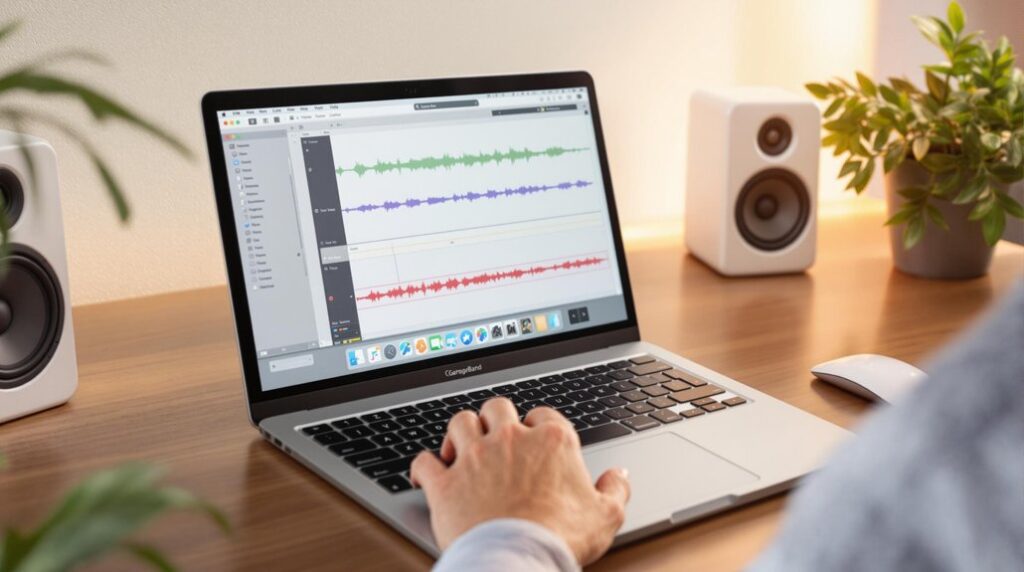Mastering crossfading in GarageBand begins with a firm grasp of linear and exponential crossfade techniques to create a seamless auditory experience. Start by overlapping audio regions, using hotkeys for efficiency, and guaranteeing synchronized levels to avoid jarring shifts. Activate Automation View to access volume control points for refined fades, adjusting overlap length and volume modulation meticulously. Experiment with fade handles and playback features, fine-tuning for any popping sounds or volume inconsistencies. Pay attention to EQ adjustments to maintain audio quality. Document your settings for future projects. This process guarantees a cohesive, polished soundscape, inviting further exploration into advanced techniques.
Key Takeaways
- Activate Automation View by pressing 'A' to manage volume transitions.
- Use crossfade options in GarageBand to eliminate clicks between audio segments.
- Adjust fade handles for optimal length and curvature for high sound quality.
- Highlight overlapping regions and use hotkeys for efficient editing.
- Monitor playback to refine crossfades and ensure a seamless auditory experience.
Understanding Crossfade Basics
In the field of audio production, understanding the fundamentals of crossfades is essential for crafting smooth auditory shifts. A crossfade seamlessly shifts between audio files, enhancing the listening experience by mitigating abrupt sound changes. This technique is pivotal, facilitating the recording process by segmenting sections, refining pacing, and eliminating disruptive clicking sounds.
Crossfades are primarily categorized into linear and exponential types, each imparting distinct sound characteristics and dynamics. Linear crossfades maintain a constant rate of change, while exponential ones offer a more natural, gradual shift.
Significantly, digital audio workstations (DAWs) like GarageBand feature built-in crossfade options, streamlining their application. Mastery of crossfading demands meticulous attention to overlap length, volume modulation, and EQ adjustments to preserve clarity and continuity in audio compositions.
Preparing Your Audio Tracks
Having grasped the fundamentals of crossfades, it is now pivotal to meticulously prepare your audio tracks to execute this technique effectively within GarageBand. Begin by confirming the presence of at least two audio regions with overlapping sections to facilitate seamless blending. Select and highlight these regions in the timeline for focused editing. Regular practice of hotkey commands, like Command + T and Command + C, can significantly expedite your workflow and enhance editing accuracy.
| Step | Description |
|---|---|
| Select Audio | Click and highlight audio regions in timeline |
| Overlap Regions | Confirm overlapping sections for blending |
| Zoom In | Precisely manage crossfade points |
| Match Levels | Align audio levels to avoid abrupt changes |
Zoom in on overlapping sections to manage crossfade points with precision. Before proceeding, verify that audio levels are matched to avoid abrupt shifts. This meticulous preparation confirms that your audio track flows smoothly, achieving professional-grade results.
Activating Automation View
Release the potential of your audio editing by activating Automation View in GarageBand, an essential step for mastering crossfades with precision. By simply pressing the shortcut key 'A' within the mix menu, you reveal the intricate volume automation lines across your selected tracks. This activation is significant, offering a visual representation of the yellow volume line that guides your crossfading process. Within the automation view, you have the power to add volume points, ensuring seamless and smooth changes between audio regions. Precision in these adjustments is key, allowing you to manipulate the volume levels of overlapping tracks effortlessly. Once your crossfading finesse is achieved, return to the standard editing interface by pressing 'A' again, solidifying your audio masterpiece. Use dynamic panning to enhance audio immersion by creatively shifting sound between speakers, adding another layer of depth to your crossfade transitions.
Duplicating the Track
Achieve impeccable control over your audio shifts by duplicating the track in GarageBand, an essential technique for refined crossfading. This method allows you to experiment with audio manipulations while protecting the integrity of the original track.
To execute this, simply select your desired track and employ the keyboard shortcut Command + D, producing an exact replica positioned directly beneath the original. This strategic alignment guarantees seamless synchronization and precise timing, which are vital for effective crossfading.
By manipulating the duplicated track, you can create smooth shifts, enhancing the auditory experience. Remember to methodically rename the duplicated track, an important step in maintaining organizational clarity within complex projects.
This structured approach facilitates creativity and precision in your crossfading endeavors.
Setting Volume Automation
Activate the dynamic potential of your audio projects in GarageBand by mastering the art of setting volume automation.
Begin by pressing 'A' to reveal the automation view, showing the yellow volume control line across each track. This feature is essential for crafting seamless changes, as it allows the creation of precise volume automation points.
By clicking directly on the volume line, you can manipulate these points, using flexible volume dots to expertly orchestrate fade-ins and fade-outs. Raise or lower these points to modulate the audio intensity at any chosen interval.
Overlapping audio regions is vital; it guarantees the volume automation fosters a fluid crossfade. Continuously preview your adjustments to confirm a polished, natural-sounding change between tracks. To enhance the mix clarity and ensure a cohesive sound, consider cutting around the 200-400 Hz range to address frequency muddiness and improve vocal intelligibility.
Creating Volume Control Points
Building on the foundation of volume automation, the intricate process of creating volume control points in GarageBand enhances your ability to finely sculpt audio dynamics. Follow these steps for precision:
- Activate Automation View: Press 'A' to reveal tracks available for volume adjustments. This enables a clear view of the automation lanes.
- Add Volume Points: Click on the yellow volume line in your track. Each click introduces a volume point, allowing for meticulous control over audio levels at desired time intervals.
- Adjust Volume Points: Click and drag these points to alter their position. This feature facilitates both gradual fades and abrupt volume shifts.
- Refine Changes: Experiment with multiple volume points closely placed. Zoom in on the timeline for enhanced accuracy in crafting seamless crossfades.
In your GarageBand project setup, ensure that the tempo and key signature are appropriately adjusted, as these settings can impact the overall sound quality and integration of your crossfades.
Adjusting Track Overlap
Crafting a seamless audio shift in GarageBand hinges on the artful adjustment of track overlap. For effective crossfading, guarantee that the two audio regions have a sufficient overlap, ideally of a few milliseconds. This vital overlap facilitates smooth shifts between tracks.
Utilize the fade handles on each audio clip to meticulously control the overlap duration, tailoring the crossfade to achieve a personalized sound profile. Accurate placement of volume automation points is essential; zoom in on crossfade points for precision.
Harmonizing the volume levels of both tracks before overlapping is necessary to avoid abrupt loudness changes. Experimentation is key—adjust fade handles and listen critically to different overlap lengths to discover the best blend for your specific tracks.
Refining Fade Transitions
When refining fade shifts in GarageBand, ensuring that overlapping audio regions are suitably aligned is essential for achieving a seamless sound blend. Utilizing fade handles and precise volume control can transform a track's auditory aesthetic. Follow these steps to refine shifts:
- Overlap Alignment: Begin by aligning regions with adequate overlap, creating a foundation for smooth crossfades.
- Automation Precision: Activate the automation view by pressing 'A'. Use control points on the yellow line for meticulous volume modulation.
- Fade Handle Adjustment: Experiment with the length and curvature of fade handles. This experimentation is vital as settings can dramatically influence sound quality.
- Zoom for Detail: Zoom in on crossfade points for fine-tuning. Balance volume levels meticulously before finalizing edits, ensuring a polished auditory experience.
To optimize your audio editing, it's important to master software navigation in GarageBand, as it will allow for efficient edits and sound enhancements.
Previewing and Testing Fades
Having meticulously aligned and refined your fade shifts, it's imperative to focus on previewing and testing the crossfades to confirm a flawless sonic experience.
Begin by utilizing GarageBand's playback feature, guaranteeing the fluidity of the audio blend. Pay close attention to any popping sounds or volume inconsistencies, which may necessitate further adjustments.
Employ the zoom tool to scrutinize crossfade points with precision, facilitating meticulous tweaking during the preview process. Adjust the overlap duration based on critical listening tests, enhancing the auditory quality and effectiveness of the fades.
Save multiple versions of your project before and after alterations, allowing you to compare and revert changes if necessary. This practice confirms that your crossfades achieve the desired seamless auditory flow.
Tips for Effective Crossfading
To achieve seamless crossfades in GarageBand, it's essential to experiment with various fade lengths to discover the best change that complements your audio content.
This tailoring of crossfading techniques guarantees smoothness and a professional finish. Here are four expert tips to enhance your crossfading skills:
- Match Audio Levels: Ensure consistency by aligning audio levels before crossfading, preventing disruptive volume fluctuations.
- EQ Adjustments: Fine-tune the equalizer to minimize frequency clashes between tracks, facilitating a cleaner, balanced mix.
- Critical Listening: After applying crossfades, listen critically to changes, making necessary adjustments to optimize smoothness.
- Version Control: Save multiple project versions during editing, providing a comparative analysis for selecting the most effective crossfade techniques.
To further enhance your audio projects, consider utilizing automation techniques in GarageBand, which allow for dynamic adjustments in reverb and delay levels, creating a more nuanced and evolving soundscape. These strategies refine your crossfading artistry in GarageBand.
Frequently Asked Questions
How to Do a Crossfade in Garageband?
To effectively implement crossfade techniques in GarageBand, first align overlapping audio regions, then engage automation view for volume adjustments. Utilize fade handles for smooth shifts, add precise automation points, and conduct thorough previewing to guarantee seamless audio blending.
How to Blend Songs Together on Garageband?
To achieve professional song mixing in GarageBand, import tracks, enable automation, and adjust crossfade parameters. Utilize fade handles and volume automation for seamless shifts, ensuring precise blending by iterating adjustments. Preview thoroughly for ideal auditory synthesis.
Does Garageband Have Transition Sounds?
GarageBand lacks pre-defined shift sounds; however, users can craft Transition Effects by employing audio clips, crossfades, and imported sounds. The software's built-in effects and automation tools facilitate creating innovative, smooth shifts between audio segments.
How Do You Transpose Tracks in Garageband?
To transpose tracks in GarageBand, utilize the Smart Controls for precise track adjustment. Access the "Pitch" section to modify semitones, ensuring harmonious integration. Additionally, the "Region" inspector facilitates transposing MIDI tracks, enhancing creative flexibility and audio fidelity.
Conclusion
Mastering crossfading in GarageBand requires a thorough understanding of both technical and creative elements. By grasping the fundamentals of crossfade, preparing audio tracks meticulously, and utilizing features such as Automation View, users can achieve seamless changes. Duplicating tracks and setting precise volume automation further enhance the process. Adjusting track overlap and refining fade changes guarantee smooth audio blending. Through previewing and iterative testing, one can attain professional-grade results. Effective crossfading is both an art and a science, requiring attention to detail and a keen auditory sense.




